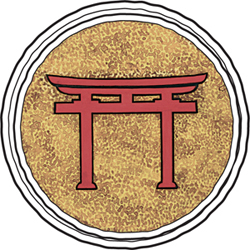Shintoism
FOUNDED: Shintoism began around 2,500–3,000 years ago in Japan.§
FOUNDER: Each of the thirteen ancient sects has its own founder.§
MAJOR SCRIPTURES: Kojiki (Record of Ancient Things), Nihongi (Chronicles of Japan), a later work, Yengishiki (Institutes of the period of Yengi), and the Collection of Ten Thousand Leaves are the primary works, but they are not regarded as revealed scripture.§
ADHERENTS: Estimated at 30 million, mostly in Japan.
Most are also Buddhists.§
There are two main divisions. One is the thirteen ancient sects, all very similar. The second is known as State Shinto, and is a later synthesis finding its highest expression in the worship of the Emperor and loyalty to the State and family. Shinto (from the Chinese characters Shen and Tao, signifying the “Way of the Spirits”) is called Kami-no-michi in vernacular Japanese. Kami are the innumerable Gods or nature spirits. Shinto shrines are many, over 100,000 in Japan. In the shrines no images are worshiped, rather it is considered that the Kami themselves are there. Fresh foods, water, incense, etc., are offered daily upon the altar. There is an inward belief in the sacredness of the whole of the universe, that man can be in tune with this sacredness. Stress is placed on truthfulness and purification through which man may remove the “dust” which conceals his inherently divine nature and thus receive the guidance and blessings of Kami. The Shintoist’s ardent love of the motherland has found unique expression in the loyalty and devotion of the Japanese people to their state institutions.§
The primary goal of Shintoism is to achieve immortality among the ancestral beings, the Kami. Kami is understood by the Shintoist as a supernatural, holy power living in or connected to the world of the spirit. Shintoism is strongly animistic, as are most Eastern and Oriental faiths, believing that all living things possess a Kami nature. Man’s nature is the highest, for he possesses the most Kami. Salvation is living in the spirit world with these divine beings, the Kami.§
Salvation is achieved in Shinto through observance of all taboos and the avoidance of persons and objects which might cause impurity or pollution. Prayers are made and offerings brought to the temples of the Gods and Goddesses, of which there are said to be 800 myriad in the universe. Man has no Supreme God to obey, but needs only know how to adjust to Kami in its various manifestations. A person’s Kami nature survives death, and a man naturally desires to be worthy of being remembered with approbation by his descendants. Therefore, fulfillment of duty is a most important aspect of Shinto.§
- I believe in the “Way of the Gods,” Kami-no-michi, which asserts nature’s sacredness and uniquely reveals the supernatural.
- I believe there is not a single Supreme Being, but myriad Gods, superior beings, among all the wonders of the universe which is not inanimate but filled everywhere with sentient life.
- I believe in the scriptural authority of the great books known as the Record of Ancient Things, Chronicles of Japan, Institutes of the Period of Yengi and Collection of Ten Thousand Leaves.
- I believe in the sanctity of cleanliness and purity—of body and spirit—and that impurity is a religious transgression.
- I believe that the State is a divine institution whose laws should not be transgressed and to which individuals must sacrifice their own needs.
- I believe in moral and spiritual uprightness as the cornerstone of religious ethics and in the supreme value of loyalty.
- I believe that the supernatural reveals itself through all that is natural and beautiful, and value these above philosophical or theological doctrine.
- I believe that whatever is, is Divine Spirit, that the world is a one brotherhood, that all men are capable of deep affinity with the Divine and that there exists no evil in the world whatsoever.
- I believe in the practical use of ceremony and ritual, and in the worship of the Deities that animate nature, including the Sun Goddess Amaterasu, the Moon God Tsuki-yomi, and the Storm God Sasa-no-wo.
